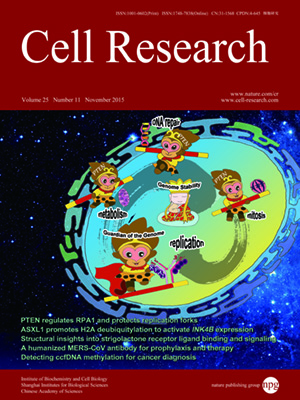
Volume 25, No 11, Nov 2015
ISSN: 1001-0602
EISSN: 1748-7838 2018
impact factor 17.848*
(Clarivate Analytics, 2019)
Volume 25 Issue 11, November 2015: 1205-1218
ORIGINAL ARTICLES
Tumor suppressor ASXL1 is essential for the activation of INK4B expression in response to oncogene activity and anti-proliferative signals
Xudong Wu1,2,3, Ida Holst Bekker-Jensen2,3, Jesper Christensen2,3, Kasper Dindler Rasmussen2,3,4, Simone Sidoli5,12, Yan Qi1, Yu Kong1, Xi Wang1, Yajuan Cui5, Zhijian Xiao6, Guogang Xu7, Kristine Williams2,3,13, Juri Rappsilber8,9, Casper Kaae Sønderby10,11, Ole Winther10,11, Ole N Jensen5 and Kristian Helin2,3,4
1Department of Cell Biology, Tianjin Medical University, Qixiangtai Road 22, Tianjin 300070, China
2Biotech Research and Innovation Centre, University of Copenhagen, Ole Maaløes Vej 5, 2200 Copenhagen, Denmark
3Centre for Epigenetics, University of Copenhagen, Ole Maaløes Vej 5, 2200 Copenhagen, Denmark
4The Danish Stem Cell Center (Danstem), University of Copenhagen, Blegdamsvej 3, 2200 Copenhagen, Denmark
5Centre for Epigenetics, Department of Biochemistry and Molecular Biology, University of Southern Denmark, Campusvej 55, 5230 Odense M, Denmark
6MDS and MPN Centre, Institute of Hematology and Blood Diseases Hospital, Chinese Academy of Medical Sciences & Peking Union Medical College, Tianjin 300020, China
7The Second Affiliated Hospital to Nanchang University, 1 Minde Road, Nanchang, Jiangxi 330006, China
8Wellcome Trust Centre for Cell Biology, University of Edinburgh, Edinburgh EH9 3BF, UK
9Department of Bioanalytics, Institute of Biotechnology, Technische Universität Berlin, 13355 Berlin, Germany
10Cognitive Systems, DTU Compute, Technical University of Denmark, 2800 Lyngby, Denmark
11Bioinformatics Centre, University of Copenhagen, Ole Maaløes Vej 5, 2200 Copenhagen, Denmark
12Present address: Epigenetics Program, Department of Biochemistry and Biophysics, Perelman School of Medicine, University of Pennsylvania, 3400 Civic Center Blvd, Philadelphia, PA, USA
13Present address: The Novo Nordisk Foundation Center for Basic Metabolic Research, University of Copenhagen, Blegdamsvej 3, 2200 Copenhagen, Denmark
Correspondence: Kristian Helin, E-mail: kristian.helin@bric.ku.dk Tel: +45 3532 5666; Fax: +45 3532 5669Xudong Wu, E-mail: wuxudong@tijmu.edu.cn(+86 8333 6825;)
ASXL1 mutations are frequently found in hematological tumors, and loss of Asxl1 promotes myeloid transformation in mice. Here we present data supporting a role for an ASXL1-BAP1 complex in the deubiqutinylation of mono-ubiquitinylated lysine 119 on Histone H2A (H2AK119ub1) in vivo. The Polycomb group proteins control the expression of the INK4B-ARF-INK4A locus during normal development, in part through catalyzing mono-ubiquitinylation of H2AK119. Since the activation of the locus INK4B-ARF-INK4A plays a fail-safe mechanism protecting against tumorigenesis, we investigated whether ASXL1-dependent H2A deubiquitinylation plays a role in its activation. Interestingly, we found that ASXL1 is specifically required for the increased expression of p15INK4B in response to both oncogenic signaling and extrinsic anti-proliferative signals. Since we found that ASXL1 and BAP1 both are enriched at the INK4B locus, our results suggest that activation of the INK4B locus requires ASXL1/BAP1-mediated deubiquitinylation of H2AK119ub1. Consistently, our results show that ASXL1 mutations are associated with lower expression levels of p15INK4B and a proliferative advantage of hematopoietic progenitors in primary bone marrow cells, and that depletion of ASXL1 in multiple cell lines results in resistance to growth inhibitory signals. Taken together, this study links ASXL1-mediated H2A deubiquitinylation and transcriptional activation of INK4B expression to its tumor suppressor functions.
10.1038/cr.2015.121
FULL TEXT | PDF
Browse 3613


